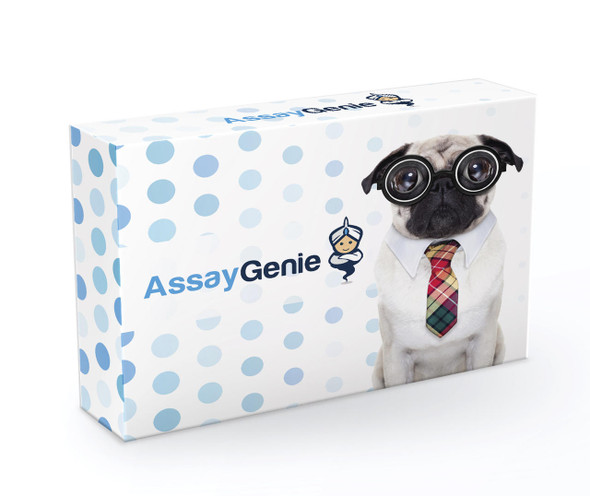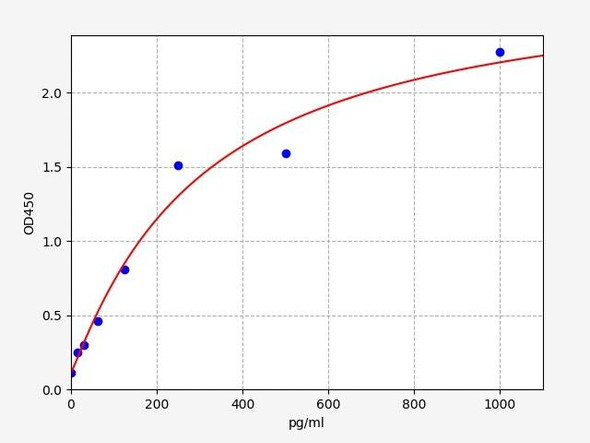Description
Hamster IL-4 ELISA Kit - Information
| Product | Sample Types | Method |
| Hamster IL-4 ELISA Kit (HMFI0006-C) | Tissue, Cell Culture Supernatant, Cell Lysate | Competitive |
| Hamster IL-4 ELISA Kit (HMFI0006-S) | Serum/Plasma | Sandwich |
How do our Hamster IL-4 ELISA Kit Work?
This Hamster IL-4 ELISA Kit is based on Competitive-ELISA detection method. The microtiter plate provided in this kit has been pre-coated with analyte of interest. During the reaction, the analyte in the sample or standard competes with a fixed amount of target on the solid phase supporter for sites on the Biotinylated Detection Antibody specific to analyte. Excess conjugate and unbound sample or standard are washed from the plate, and HRP-Streptavidin (SABC) is added to each microplate well and incubated. TMB substrate solution is then added to each well. The enzyme-substrate reaction is terminated by the addition of a sulphuric acid solution and the colour change is measured spectrophotometrically at a wavelength of 450nm. The concentration of target in the samples is then determined by comparing the OD of the samples to the standard curve.
Hamster IL-4 ELISA Kit Data
| Product Code | HMFI0006-C |
| Uniprot | Q60440 |
| Alias | IL-4, Interleukin 4, IL4, BCGF-1, BCGF1, BSF-1, BSF1 |
| Detection method | Competitive ELISA, Coated with Antibody |
| Species | Hamster |
| Application | Tissue, Cell Culture Supernatant, Cell Lysate |
| Size | 96T |
| Range | 15.625-1000pg/ml |
| Sensitivity | 9.375pg/ml |
| Storage | 2-8°C for 6 months |
| CV(%) | Intra-Assay: CV<8% Inter-Assay: CV<10% |
| Note | For Research Use Only |
Hamster IL-4 ELISA Kit Protocol
The below protocol is a sample protocol for Hamster IL-4 ELISA Kit. Competitive ELISA kits allow for the detection and quantification of an analyte in a sample. This Hamster IL-4 ELISA Kit allows the researcher to calculate the amount of IL-4 in their sample. Equilibrate the TMB substrate for at least 30 min at 37°C before use. When diluting samples and reagents, they must be mixed completely and evenly. It is recommended to plot a standard curve for each test.
Competitive ELISA Protocol

Kit Protocol:
| 1. | Set standard, test sample and control (zero) wells on the pre-coated plate respectively, and then, record their positions. It is recommended to measure each standard and sample in duplicate. Wash plate 2 times before adding standard, sample and control (zero) wells! |
| 2. | Add Sample and Biotin-detection antibody: Add 50µL of Standard, Blank or Sample per well. The blank well is added with Sample Dilution Buffer. Immediately add 50 µL of biotin-labelled antibody working solution to each well. Cover with the plate sealer provided. Gently tap the plate to ensure thorough mixing. Incubate for 45 minutes at 37°C. (Solutions are added to the bottom of micro-ELISA plate well, avoid touching plate walls and foaming). |
| 3. | Wash: Aspirate each well and wash, repeating the process three times. Wash by filling each well with Wash Buffer (approximately 350µL) using a squirt bottle, multi-channel pipette, manifold dispenser or automated washer. Complete removal of liquid at each step is essential to good performance. After the last wash, remove any remaining Wash Buffer by aspirating or decanting. Invert the plate and pat it against thick clean absorbent paper. |
| 4. | HRP-Streptavidin Conjugate(SABC): Add 100µL of SABC working solution to each well. Cover with a new Plate sealer. Incubate for 30 minutes at 37°C. |
| 5. | Wash: Repeat the aspiration/wash process for five times. |
| 6. | TMB Substrate: Add 90µL of TMB Substrate to each well. Cover with a new Plate sealer. Incubate for about 10-20 minutes at 37°C. Protect from light. The reaction time can be shortened or extended according to the actual color change, but not more than 30minutes. When apparent gradient appeared in standard wells, you can terminatethe reaction. |
| 7. | Stop: Add 50µL of Stop Solution to each well. Color turn to yellow immediately. The adding order of stop solution should be as the same as the substrate solution. |
| 8. | OD Measurement: Determine the optical density (OD Value) of each well at once, using a microplate reader set to 450 nm. You should open the microplate reader ahead, preheat the instrument, and set the testing parameters. |
Hamster IL-4 ELISA Kit components | 96 Assays | Storage |
| ELISA Microplate(Dismountable) | 8×12 strips | 4°C for 6 months |
| Lyophilized Standard | 2 | 4°C/-20°C |
| Sample/Standard Dilution Buffer | 20ml | 4°C |
| Biotin-labeled Antibody(Concentrated) | 60ul | 4°C (Protect from light) |
| Antibody Dilution Buffer | 10ml | 4°C |
| HRP-Streptavidin Conjugate(SABC) | 120ul | 4°C (Protect from light) |
| SABC Dilution Buffer | 10ml | 4°C |
| TMB Substrate | 10ml | 4°C (Protect from light) |
| Stop Solution | 10ml | 4°C |
| Wash Buffer(25X) | 30ml | 4°C |
| Plate Sealer | 5 | - |
Other materials and equipment required:
The Assay Genie Hamster IL-4 ELISA Kit will require other equipment and materials to carry out the assay. Please see list below for further details.
- Microplate reader with 450 nm wavelength filter
- Multichannel Pipette, Pipette, microcentrifuge tubes and disposable pipettetips
- Incubator
- Deionized or distilled water
- Absorbent paper
- Buffer resevoir
Sample Preparation
When carrying out an ELISA assay it is important to prepare your samples in order to achieve the best possible results. Below we have a list of proceduresfor the preparation of samples for different sample types.
| Sample Type | Protocol |
Serum | If using serum separator tubes, allow samples to clot for 30 minutes at room temperature. Centrifuge for 10 minutes at 1,000x g. Collect the serum fraction and assay promptly or aliquot and store the samples at -80°C. Avoid multiple freeze-thaw cycles. If serum separator tubes are not being used, allow samples to clot overnight at 2-8°C. Centrifuge for 10 minutes at 1,000x g. Remove serum and assay promptly or aliquot and store the samples at-80°C. Avoid multiple freeze-thaw cycles. |
Plasma | Collect plasma using EDTA or heparin as an anticoagulant. Centrifuge samples at 4°C for 15 mins at 1000 × g within 30 mins of collection. Collect the plasma fraction and assay promptly or aliquot and store the samples at -80°C. Avoid multiple freeze-thaw cycles.Note: Over haemolysed samples are not suitable foruse with this kit. |
Urine & Cerebrospinal Fluid | Collect the urine (mid-stream) in a sterile container, centrifuge for 20 mins at 2000-3000 rpm. Remove supernatant and assay immediately. If any precipitation is detected, repeat the centrifugation step. A similar protocol can be used for cerebrospinal fluid. |
Cell culture supernatant | Collect the cell culture media by pipette, followed by centrifugationat 4°C for 20 mins at 1500 rpm. Collect the clear supernatant and assay immediately. |
Cell lysates | Solubilize cells in lysis buffer and allow to sit on ice for 30 minutes. Centrifuge tubes at 14,000 x g for 5 minutes to remove insoluble material. Aliquot the supernatant into a new tube and discard the remaining whole cell extract. Quantify total protein concentration using a total protein assay. Assay immediately or aliquot and store at ≤ -20 °C. |
Tissue homogenates | The preparation of tissue homogenates will vary depending upon tissue type. Rinse tissue with 1X PBS to remove excess blood & homogenizein 20ml of 1X PBS (including protease inhibitors) and store overnight at ≤ -20°C. Two freeze-thaw cycles are required to break the cell membranes. To further disrupt the cell membranes you can sonicatethe samples. Centrifuge homogenates for 5 mins at 5000xg. Remove the supernatant and assay immediately or aliquot and store at -20°C or-80°C. |
Tissue lysates | Rinse tissue with PBS, cut into 1-2 mm pieces, and homogenize with atissue homogenizer in PBS. Add an equal volume of RIPA buffer containing protease inhibitors and lyse tissues at room temperaturefor 30 minutes with gentle agitation. Centrifuge to remove debris. Quantify total protein concentration using a total protein assay. Assay immediately or aliquot and store at ≤ -20 °C. |
Breast Milk | Collect milk samples and centrifuge at 10,000 x g for 60 min at4°C. Aliquot the supernatant and assay. For long term use, storesamples at -80°C. Minimize freeze/thaw cycles. |






